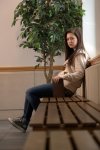Hi guys I'm really sorry about making another thread like this straight after the previous one.
It's just that I'm starting shooting a short documentary on Monday and I just wanted to get some basic questions cleared up so it will be the best it can be! I'm in Australia so the names of some products might be different.
I'll number the questions to make it easier to read!
1)Foamcore: I went into an office supply store, Office Works, to ask for foamcore. What they showed me wasn't called foamcore, I can't remember what it was called but I'm fairly certain it's the same thing. It looked similar to the images of Foamcore I've googled but the surfaces were slightly glossy.
Would this matter?
I'm concerned mainly about the Black piece as I plan to use subtractive lighting (blocking eye shadows from overhead lights etc)
2)If I have two or more light sources on the shoot will it bugger up my white balance? EG: I'm indoors in a Gym and there is light coming through the windows from the sun, lights in the roof of the gym and an LED light block that that I'm using for Key, and they are all different temperatures.
Will they all combine into one different colour temperature so I can set my white balance to that new general temperature?
3)Expanding from that previous question, I really want to use 1 strong key light only, on top of the other lights on the location, not quite high contrast/low key style but just enough so I can underexpose the scene a bit and have the Key source at a more "proper" exposure to make it look a bit moody. I've already got a Z96 led block light so I was wondering if this would suffice or would it be better to get a clamp light or something? I really like the softer look of china balls but this project I want a more contrasty feel.
4) About the clamp lights or other lights like flood lights or something, do I need to worry about which colour temp light bulb I use in them or can I just get any colour and adjust my white balance?
Thanks in advance!
It's just that I'm starting shooting a short documentary on Monday and I just wanted to get some basic questions cleared up so it will be the best it can be! I'm in Australia so the names of some products might be different.
I'll number the questions to make it easier to read!
1)Foamcore: I went into an office supply store, Office Works, to ask for foamcore. What they showed me wasn't called foamcore, I can't remember what it was called but I'm fairly certain it's the same thing. It looked similar to the images of Foamcore I've googled but the surfaces were slightly glossy.
Would this matter?
I'm concerned mainly about the Black piece as I plan to use subtractive lighting (blocking eye shadows from overhead lights etc)
2)If I have two or more light sources on the shoot will it bugger up my white balance? EG: I'm indoors in a Gym and there is light coming through the windows from the sun, lights in the roof of the gym and an LED light block that that I'm using for Key, and they are all different temperatures.
Will they all combine into one different colour temperature so I can set my white balance to that new general temperature?
3)Expanding from that previous question, I really want to use 1 strong key light only, on top of the other lights on the location, not quite high contrast/low key style but just enough so I can underexpose the scene a bit and have the Key source at a more "proper" exposure to make it look a bit moody. I've already got a Z96 led block light so I was wondering if this would suffice or would it be better to get a clamp light or something? I really like the softer look of china balls but this project I want a more contrasty feel.
4) About the clamp lights or other lights like flood lights or something, do I need to worry about which colour temp light bulb I use in them or can I just get any colour and adjust my white balance?
Thanks in advance!


 Eventually, you'll develop the skill to be let down by these lights and need to spend more to move up past them. When I was still using clamp lights, I found myself using 4 or 5 of them on the key side of my actors with the maximum wattage bulb in them I could safely use in each... 150w x 4 = 600w of light... at $50/light, the $150 650w Arri knockoff is a great cost savings at 3/4 the cost... plus it comes with a nice tall stand.
Eventually, you'll develop the skill to be let down by these lights and need to spend more to move up past them. When I was still using clamp lights, I found myself using 4 or 5 of them on the key side of my actors with the maximum wattage bulb in them I could safely use in each... 150w x 4 = 600w of light... at $50/light, the $150 650w Arri knockoff is a great cost savings at 3/4 the cost... plus it comes with a nice tall stand.






